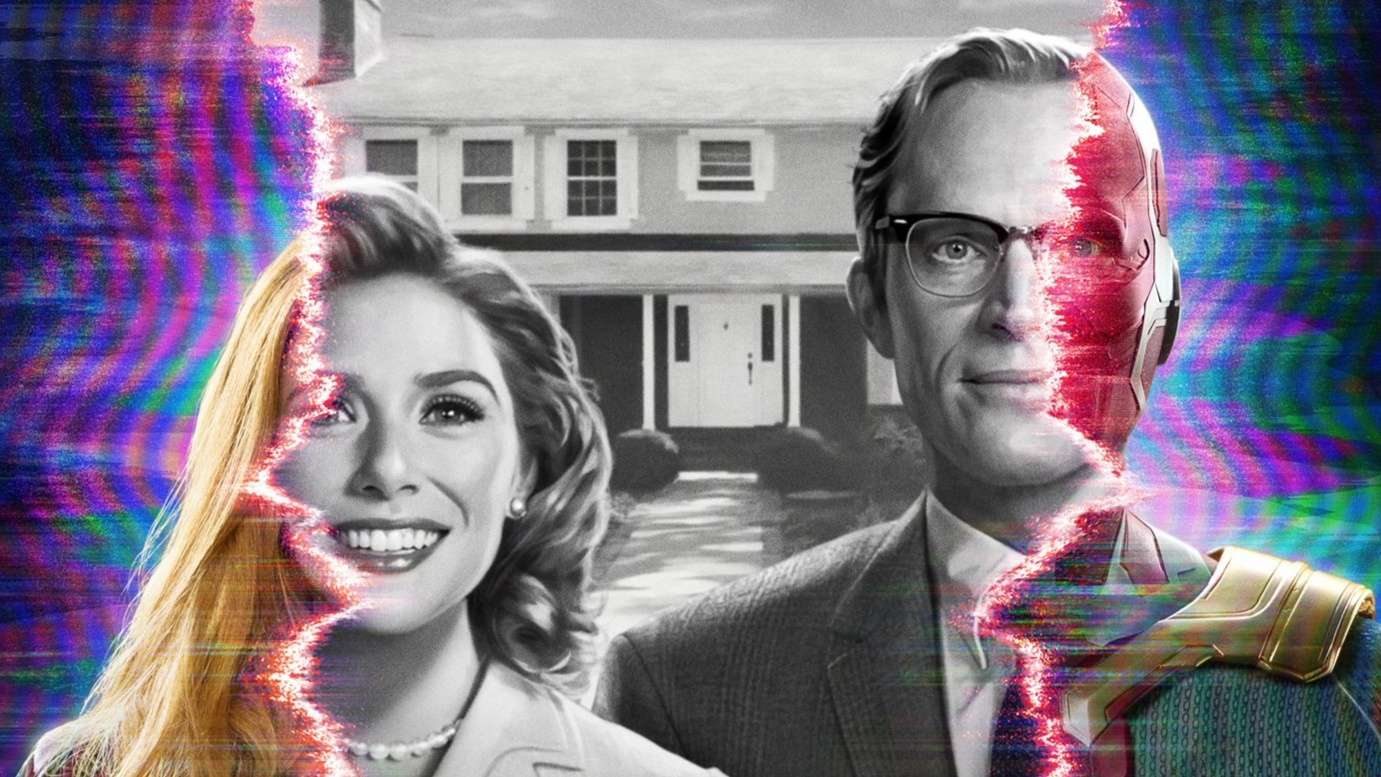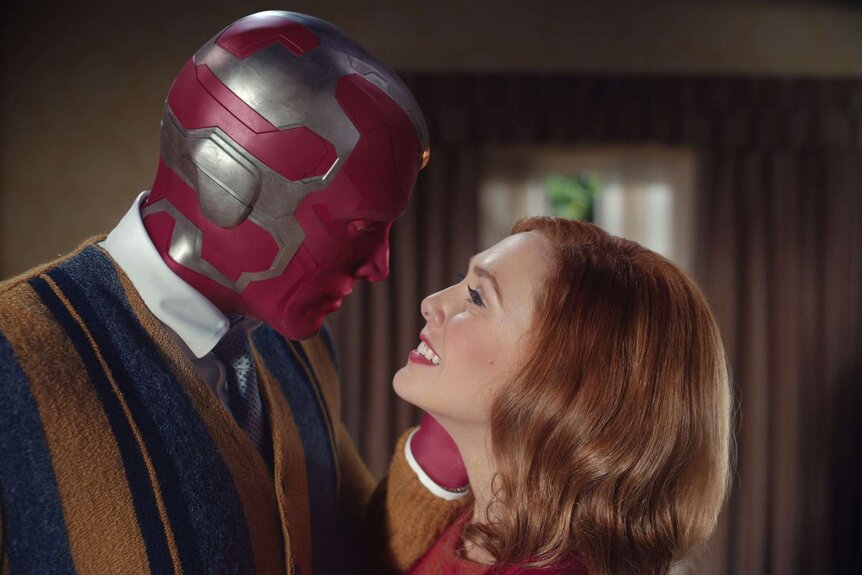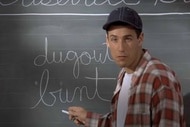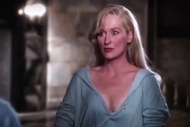Create a free profile to get unlimited access to exclusive videos, sweepstakes, and more!
WandaVision is the most important thing to happen to the MCU since Iron Man

For Marvel fans, there is life before and life after WandaVision.
The first Disney+ show to bring the Marvel Cinematic Universe to the small screen, featuring Wanda Maximoff (Elizabeth Olsen) and Vision (Paul Bettany), is poised to do for the next phase of the MCU what Iron Man did for the first: change everything.
Compared to Tony Stark's first movie, the risk is much lower for Marvel. The now-Disney-owned company has proven to be a load-bearing column in pop culture's foundation for 13 years, and it didn't need to take out an incredibly risky loan to self-finance the Disney+ series. But, from a narrative standpoint, WandaVision is a very risky proposition. It is the biggest (and most inventive) creative swing Marvel Studios has taken in live-action: Drop two popular comic book characters into a reality built with vintage sitcom tropes and use it as a launchpad for the future of a billion-dollar empire. And fans haven't seen one of those characters, Vision, since 2018's Avengers: Infinity War — where he died. Twice.
Figuring out how this is all possible — and what it says about Wanda's state of mind following the death of her true love — gives WandaVision a mystery-style plot unlike any that Marvel has tackled before. It also invests the drama with an emotional storyline firmly rooted in backstory, one seemingly more character-driven and potentially heartbreaking than any previous MCU outing. It's here that Marvel charts new territory by using familiar characters to subvert expectations on what the "comic book movie" genre can do, just like Kevin Feige and director Jon Favreau did with the first Iron Man movie. Loosely inspired by Tom King's excellent 2016 The Vision comic, WandaVision plans to bridge the post-Endgame state of the MCU with Phase Four's ventures into the multiverse. And, in doing so, WandaVision carves a new path for Marvel that will likely prove just as game-changing as the one Tony Stark helped created in Summer 2008.
Then, no one knew what to expect with taking a then-B-list hero like Iron Man and giving him the summer blockbuster treatment. Having worked at Paramount at the time of the first film's release, no one at the studio expected Iron Man to be, well, Iron Man. Save for Feige.
So it's no surprise that he provided the kernel for what would become WandaVision — casting these two iconic characters as the stars of very "Nick at Nite"-esque shows (complete with black-and-white visuals and laugh tracks), shows that the head of Marvel Studios once loved to watch. What is so impressive about WandaVision is how firmly committed it is to this narrative choice. It goes all-in, from the '50s aspect ratio to the actors' block for a three-camera setup. The show plays it straight, never laughing at its characters or its audience as Wanda and Viz negotiate vintage sitcom plots (dinner with the boss goes awry, for example). Employing their unique powersets, and bound by their connected histories, the characters engage with their new reality in ways that make it increasingly difficult for them to do so without feeling more out of place in a time period designed to make everyone fit in.
Viz's newfound "life" is as tenuous as the black-and-white reality to which it is tethered. As is the mental health of his "wife," Wanda.
As Marvel's version of a telekinetic Donna Reed, Wanda is all smiles and well-quaffed hair in the quaint, idyllic suburb of Westview. Her smiles fade, however, by the middle of the second episode, when she suspects something is, at best, "off" with the increasingly-fractured reality around her — one she may have helped create to cope with the loss of Viz. Or a reality that someone — possibly an organization of someones — has put her in. When Wanda's not hearing what many believe to be Randall Park's S.H.I.E.L.D. agent Jimmy Woo trying to reach her via old-timey radio, a TV commercial for a HYDRA-branded watch, the Strucker, is a tell-tale sign that S.H.I.E.L.D.'s former nemesis has a significant role in Wanda's sitcom life. (Baron von Strucker, played by Thomas Kretschmann in Avengers: Age of Ultron, was the scientist responsible for turning the Maximoff sibling into Scarlet Witch and Quicksilver.) These Easter eggs, along with nods to the new agency Nick Fury works for, S.W.O.R.D., are signs that Wanda also has a more significant role in the MCU's future than previously believed.
As the most powerful Avenger, with the ability to manipulate reality the way Doctor Strange wields magic, it seems that she is being groomed to take over for Tony Stark as the chief protector or custodian of the world of the MCU. Or, at the very least, emerge as the source for the multiverse Marvel Studios plans to explore in Tom Holland's upcoming Spider-Man threequel and in Sam Raimi's Doctor Strange in the Multiverse of Madness, the latter of which also stars Scarlet Witch. Whatever "madness" she and the Sorcerer Supreme will grapple with in the upcoming sequel, dollars-to-donuts the origins of that can be pegged to her time in Westview.
There's also the potential for Wanda's mutant heritage to be addressed, a first for the MCU. At the time of Wanda's inclusion in Age of Ultron, the film rights to the X-Men — and any and all use of "mutants" as they pertained to Marvel Comics — were owned by 20th Century Fox. Since that time, Marvel's parent company, Disney, has bought 20th Century Fox, meaning that MCU mutants are now a possibility. In addition to beta testing the concept of the multiverse, WandaVision could also pilot the introduction of mutantkind into the Avengers' world — and, in doing so, potentially set up a universe where new versions of Storm and Wolverine join Wanda in pushing Marvel's deep bench of heroes forward.
Not bad for a character who got her start in the ruins of Sokovia, on her way to becoming a vital building block in an ever-expanding world.
Before audiences get to see the payoffs of what WandaVision is setting up, they have to first experience the here and now of this new chapter in Wanda and Viz's romance. And as viewers do so at ground level with our heroes — so we experience all the twists and turns as they do — it's highly unlikely anyone could have predicted that this is where Feige's great experiment would end up. One that started in a cave with Robert Downey Jr. in the Mark I suit and ended up in a sitcom's kitchen.
And when WandaVision is done, like Iron Man before it, nothing will ever be the same.















